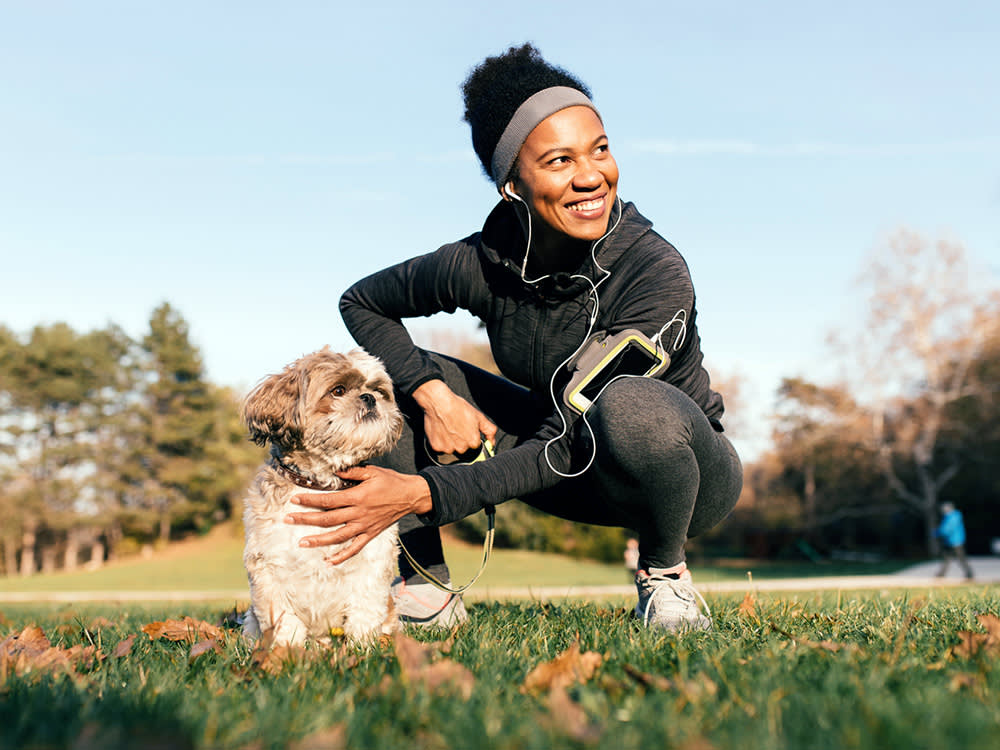Workouts You Can Do With Your Dog – From Doga to Canicross
Walking is fun, but let’s kick things up a gear
If you’ve set yourself a resolution to be more active, kudos to you for taking that first step to live a healthier lifestyle. But as previous resolutions you may have set will attest, life has a pesky habit of getting in the way. It can be really, really hard to find the motivation to get moving and keep moving regularly. The secret? To find an exercise you enjoy. As a pup parent, you clearly enjoy spending time with your dog so why not make exercising fun by including your dog in your workout plan?
Whether you’re drawn to a refreshing dip in the ocean, a snappy circuit session or a more zen-like approach, we’ve considered a whole bunch of fitness forms beyond the typical walkopens in new tab for you and your furry friend to explore in the coming year. Worried about including your dog in your workout safely? We’ve enlisted dog fitness expert, Lindsay Johnson from Cani-Fit Academyopens in new tab to provide you with top tips and advice on exercising with your dog.
Trick question: All dogs are perfect! But find out which type is the best fit for you.
Running with your dog
Jogging with your furry friend is a fantastic way to boost both you and your dog’s physical and mental well-being. The diverse sights, sounds and scents encountered during a run provide mental stimulation, warding off anxiety and boredom. Optimal for exploration, running allows your dog to uncover even more exciting smells, especially if you choose a countryside route.
However, before transforming your routine into a dog-inclusive 5K, there are a few essential factors to consider. Start gradually if your dog is new to running; don’t just clip on their leadopens in new tab and take off sprinting. If aiming for a personal best time, it’s best to leave your pet behind, as jogging with your dog involves frequent stops for sniffing, picking up poo and interactions with other wagging tails.
How much do you spend on your pet per year?
“Running with your dog is a win-win – you both get exercise in at the same time,” says Lindsay. “However, it’s not always safe to run with your dog off-lead, and certain hard surfaces could be sore on their joints.”
If using a lead, proper training is essential to avoid unexpected tumbles and lead tugging, which may harm the dog’s neck. It’s also a good idea to avoid long runs on concrete and choose a route with grass or woodland.
While certain breeds like Huskies, gun dogs, Dalmatians or Golden Retrievers make excellent running partners, others may not share the enthusiasm, like Pugs or Frenchies. Brachycephalic breeds, with their unique facial anatomy, may encounter breathing difficulties during exercise and struggle with efficient cooling down, making walking a safer option for them.
Similarly, small or toy breeds, such as Chihuahuas and Yorkshire Terriers, may find jogging challenging due to their little legs, making a brisk walk a more enjoyable and secure choice for these dogs.
Canicross
If you want to step up the running and take your fitness to the next level, why not try Canicrossopens in new tab. It’s a sport that involves your dog running in front pulling while you both run along navigating trails as one team.
“Canicross is a great option for the fit, active dogs. It’s a fantastic sport to develop teamwork, strength, fitness and focus with your dog,” says Lindsay. “It will also strengthen the bond between a runner and dog as you are a little team.”
“For Canicross, you will need a long harness, bungee line and a Canicross belt for the runner. This equipment will make the sport more comfortable for both and also easier to put the skills into practice,” says Lindsay. “You will need trail shoes for grip, a Canicross kit, and the willingness to take your running experience up a notch and get a bit muddy.”
Surface type and environment are also crucial. “Soft-defined trails that are interesting and kind to paws and joints are important. Your dog is not only running but they require a nice surface to dig and pull,” says Lindsay.
“The majority of breeds can do this sport as long as they are fit to run and pull. Dogs should be around 12 months before they start to run in a harness, then 18 months before intensity and mileage are built.”
However, Canicross shouldn’t replace your regular walking, free running or general training – it’s a complement to your dog’s regular exercise.
“My advice would be to join a class or local club as your dog will enjoy training along with other dogs and you will learn a lot more being part of a wider group,” adds Lindsay. A quick Google should link you up with your local crew.
Wild swimming with your dog
Swimming is a great activity for dogs, and if you have a breed that jumps at the sight of water, then wild swimming is a great bonding experience for you both. It can increase cardiovascular fitness, boost moods and increase immunity.
Although much like running, certain breeds aren’t fond swimmers. Again, Brachycephalic breeds will struggle to breathe in the water and stay afloat, along with short-legged dogs like Corgis and Dachshunds. Long or thick double coats can also pose challenges in the water, which is why Shih Tzus tend to hate swimming. Some of the larger breeds such as Boxers may shock you as they seem, natural-born athletes, however, their faces are similar to Pugs, and they will struggle to breathe in water.
If you do want to pursue swimming with your pup, it’s important to consider the following safety tips:
Swimming should be built up gradually and safely.
A dog life jacket is essential.
Consider the temperature of the water. If it’s cold (and let’s face it, it’s outdoor water in the UK, it’s going to be cold) you must warm their muscles before the activity through a run or brisk walk and then dry your dog quickly after the swim.
Temperatures below 10C can be problematic for long swims, as the dog’s body temperature can get too low and even cause hypothermia.
Ensure your dog does not swallow too much water. If you think they have, seek medical help. Signs include lack of coordination, lethargy, nausea, bloating, vomiting, dilated pupils, glazed eyes, light gum colour and excessive salivation. Advanced symptoms include difficulty breathing, collapsing, loss of consciousness and seizures.
Avoid strong currents and tides.
Supervise your dog at all times.
Consider using a long lead. A long waterproof lead will stop your dog from adventuring too far and potentially getting into trouble.
If your dog is not a natural swimmer, consider teaching them how to swim first or if your breed hates swimming altogether, don’t force it.
Where to go wild swimming with your dog
The River Gannel, Newquay, Cornwall
Marloes Sands, Pembrokeshire, Wales
Embleton Bay, Northumberland
River Wharfe, Appletreewick, Yorkshire
Loch Morlich, Cairngorms National Park, Scotland
Circuits with your dog
If you’re a gym-goer and fancy some strength training with your best furry friend, circuits can be extremely fun with your dog. Circuit training is a method of conditioning your dog to tire them out so that your dog can start to improve their strength, power, balance, endurance and stamina.
Circuit training is a fast-paced series of exercises in which you do three to five different exercises in a row, take a rest and then do another couple of sets.
So, what’s the best way to do circuit training? Well, you can do a quick search to see if any local gyms offer dog circuits (and there are quite a few). Alternatively, you can set some up at home following instructions from a YouTube videoopens in new tab or online course.
A simple circuit could include:
Front limb stretch/rear limb stretch
Cardio exercise (one minute on a treadmill or stair climbing)
Core strength exercise
Compound strength exercise (you could lunge while your dog repeats a play bow movement)
Start with five reps of each exercise and two sets of the circuit, then you can increase as your dog advances.
Safety tips:
Avoid circuit training with puppies. Puppies should instead focus on foundational skills and work on learning the proper form and posture.
Ensure you warm up and cool down yourself and your dog before and after training.
Do not continue with multiple sets of the circuit if your dog is showing signs of fatigue.
Ensure your dog is familiar with and trained on the individual exercises.
Do not complete circuit training if your dog is currently injured.
Select exercises that work different areas of the body to avoid strain.
Yoga
Yoga with your dog, or ‘doga’ as some like to call it, has become popular over the years. You can practice yoga at home through a video class, or a virtual instructor but going to an in-person yoga class with your dog can be a great way to socialise with other pet parents.
Yoga classes usually take place at a yoga studio, your local park or a nearby beach.
During certain in-person classes, instructors might suggest allowing your dog some freedom within the studio, allowing them to wander around casually during the class. Alternatively, they may advise using this time to work on various commands with your dog. It’s a great opportunity to practice instructions like sit, down, stay, up, back up or shake. In some yoga sessions, there might even be poses specifically designed for both you and your dog, encouraging you both to attempt these postures together.
If you are thinking of joining a class, consider whether your dog is ready for an in-person meet-up. Some dogs may require a little more training beforehand, while others may get anxious in large groups. The yoga instructor would be happy to answer any concerns you might have and perhaps a smaller group could be suited to your dog to begin with.
Dancing with your dog
Exercising doesn’t have to be a chore, if you’re moving along to some music, you’ll build up a sweat without realising. Dog dancing is a popular sportopens in new tab and one you can take seriously with your dog. Remember Ashleigh and Pudseyopens in new tab on Britain's Got Talent? Tip of the icebergopens in new tab my friend.
However, it is best to start playfully by turning on music at home and rehearsing simple exercises such as turningopens in new tab or pawing. If you find that your dog is enthusiastic about this kind of activity, and seems to have a talent, you might consider attending a dog dancing course for beginners. There, you and your four-legged friend will learn the basics of this dog sport and can find out if the bright lights and sequin-filled world of dog dancing is for you. Strictly, eat your heart out.
The good news is, dancing is suitable for most breeds but it’s important to consider their size and stamina and adjust accordingly. Heavy and large dog breeds, such as Newfoundlands, for example, may not be suited to the stamping movements so you might want to consider an alternative form of exercise.


